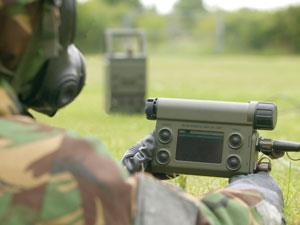
In a sunlit atrium ringed by overlooking balconies, suited men and women sit at scattered tables, consult documents and laptops, and queue for coffee. An unremarkable scene found in research institutions all over the world. At least at first glance.
But a second glance highlights the impressive adherence to security protocol. And further glances take in posters of fighter jets and the occasional figure in camouflage. Realisation dawns as a meeting concludes in a nearby room and its occupants bustle out, several of them in uniforms decorated with the ribbons of military service. This is no ordinary research institute. It is the Defence Science and Technology Laboratory (DSTL) at Porton Down, the UK’s scientific research facility for the armed forces.
‘The role of DSTL is to maximise the impact of science and technology for the defence and security of the UK,’ explains Andy Bell, DSTL’s chief technical officer. That role encompasses a wide range of work from all areas of science and engineering focused on a huge range of military and security issues over DSTL’s four main sites. But the chemists in the Chemical and Biological Radiological (CBR) area at Porton Down work to protect military personnel and, increasingly, the civilians deployed alongside them from the threats of chemical weapons.
Porton Down has a long history of dealing with these threats, going back almost a century. In October 1915, at Ypres in Belgium, thousands of French troops fell in minutes as a cloud of chlorine gas submerged their trenches, beginning a new era of chemical warfare. In 1916, Porton Down was selected to host the UK’s response, developing chemical capability and countermeasures for the military. Offensive programmes were abolished decades ago, but the chemists of DSTL’s CBR group must still deal with the legacy of chemical warfare.
‘Analytical chemistry, synthetic chemistry, modelling of dispersion of agents in the atmosphere, degradation of agents in the environment; it’s a broad range of work that we undertake in the chemistry field,’ says Bell.
Handling toxic threats
This work requires samples of chemical agents, and DSTL’s hazard assessment team contains chemists specially trained to synthesise and handle these highly toxic materials. In fact, under the terms of the Chemical Weapons Convention, Porton Down is one of the few places in the UK where scientists are legally allowed to work with these chemicals. Chris Timperley leads the chemical hazard assessment programme and the team is responsible for assessing the materials’ physical and chemical properties. ‘We start by narrowing down those materials we think could constitute a threat and we evaluate those … to understand their physical properties, and how they might be deployed,’ he explains.
We have world-renowned analytical chemistry capability
Andy Bell
‘The materials that we deal with are predominantly the traditional chemical warfare agents that have been used in the past,’ says Bell. ‘But we also have information coming from other sources that inform us of threat development.’ ‘We have to keep an open mind,’ adds Timperley. ‘People could use just about any poisonous chemical if they put their mind to it.’
The team also handles investigations into suspected chemical weapons use – and Porton Down is one of only 21 sites in the world qualified to do so. ‘We have a very strong analytical chemistry capability. It is world-renowned,’ says Bell. The techniques used are laboratory stalwarts such as mass spectrometry and NMR. But the team’s expertise can reveal much more than the presence or absence of a particular agent. ‘You can see chemicals that are left over from production and the impurities can tell you how sophisticated that agent is; you can tell if it has been stabilised, so if it’s being stored,’ explains Timperley. ‘We can tell if a site’s been decontaminated – decontaminants leave their own signatures – or even burned.’

In 2013, the lab was one of several to receive samples from Damascus in Syria, which tested positive for the nerve agent sarin. Timperley also provided expertise following the Moscow theatre siege in 2002, when Russian special forces stormed the Melnikov Street Theatre to liberate hostages held by Chechen terrorists. Before entering, the Russian forces incapacitated the assailants by flooding the theatre with an aerosol. Over 120 hostages died, overcome by the aerosol’s effects. Russian authorities would only reveal that the aerosol contained fentanyl derivatives, but samples of clothing and urine taken from the victims sent to the chemical analysis team revealed a mixture of remifentanil and carfentanil. The latter is a sedative only approved for use in animals.
Although much of the work at DSTL is necessarily classified, the team published the results of that investigation, and Bell emphasises that wherever possible, they publish their work openly. This fosters DSTL’s engagement with the research community, and it also acts as a deterrent. ‘Publishing announces that “If you use these materials, we can detect them – you will not get away with it,”’ says Bell. ‘It shows everyone you just cannot hide if you use chemical weapons; you will get caught,’ Timperley adds.
Model predictions
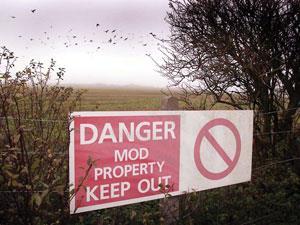
But while DSTL is allowed to synthesise chemical warfare agents for certain permitted purposes, the risks and costs involved prohibit anything but the smallest amounts. Porton Down’s 7000 acre range once saw large-scale gas dispersion tests, but today those trials are conducted virtually, on fields of silicon. Chris Hindmarsh develops the sophisticated modelling tools used to predict the behaviour of chemical agents in the environment. ‘We use models to predict the downwind hazard and the concentrations of a material,’ says Hindmarsh. ‘Typically, that chemical would be reacting as it disperses, so we have to look at the atmospheric chemistry too.’
Hindmarsh relies on the synthetic chemistry team to inform those models, and on information gathered from ‘simulant’ materials that closely approximate the physical or chemical properties of their highly toxic counterparts. ‘We’re not going to use very dangerous chemicals to look at validating dispersion models, so we take simulants that have similar properties. For instance, sulfur hexafluoride was used a long time ago. That’s environmentally unfriendly, so they use very small amounts of perfluoromethylcyclohexane diluted in air now.’
Although they are complex, the models must also be fast enough to provide real-time support to commanders in the field making decisions about hazard containment and evacuation. ‘If it’s a typical chemical warfare agent, we’ll have a lot of information already, so we can run the models quickly,’ Hindmarsh says. ‘If it’s something a little bit different that we’re not so sure of, we will go to [the synthetic chemistry] team and say “This is what we think the material is. Can you tell us what you think the density is, the viscosity?” so we can put that into our models.’
The models can also be used to understand how and where an agent was deployed and guide those teams who are sampling an area to find traces of the chemicals. ‘It also helps our people in protection, because they’ll say, “How long do I have? How long can I survive in this environment with my respirator on?”’ he says.
Porton Man
Protection is Colin Willis’ area of expertise. His work incorporates a variety of modern chemistries, exemplifying DSTL’s strategy of identifying cutting-edge research that might be turned to a defensive purpose. ‘23?years ago when I started, we would put in proposals to carry out syntheses and tests of novel materials and polymers, but we’re not always best placed to do that. So, we work with academia now,’ explains Willis.
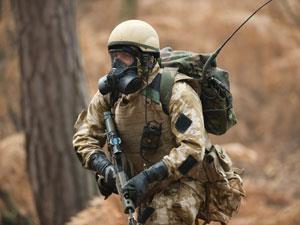
‘The vast majority of [protection research] is focused on reducing the burden associated with using protective equipment. If you put on the respirator or a protective suit, you’re impeding the body’s ability to lose heat,’ he says. Current respirators use carbon filters but Willis is investigating metal–organic frameworks as promising candidates for lighter, more effective filters. ‘[Carbon filters] are designed to take out a specific range of compounds. They can’t take out everything, or the filter would be about 10 feet long,’ explains Willis. ‘These other materials are not being produced for [defence] use but energy storage, carbon dioxide capture, that kind of thing, but they can also be applied to our problems.’
Willis also works on fluoropolymers and surface chemistry to develop liquid repellency for materials. ‘Superhydrophobicity is relatively easy to achieve because water has got such a high surface energy. But the surface energies of liquid chemical warfare agents are a lot lower. We took some chemistry developed at the University of Zurich, growing poly(methylsiloxane) nanofibres onto textiles and then using a plasma polymerisation coating technique, to produce a material that displays super repellency towards liquid chemical warfare agents.’
Between the first and second world wars, Porton Down’s scientists developed suits impregnated with DDT and with reactive materials to neutralise sulfur mustard. Today, the chemical literature abounds with smart materials and such self-cleaning, self-reporting suits and clothing are obviously attractive prospects. But on the battlefield, sophistication must again take a back seat to reliability and durability. ‘Protective clothing tends to be at the, dare I say, “agricultural” end of things. It’s got to be cheap, it’s got to be robust,’ says Willis. ‘And when you’re running across a terrain, when there’s mud and rain, you’ve got to make sure that any response you get is real.’
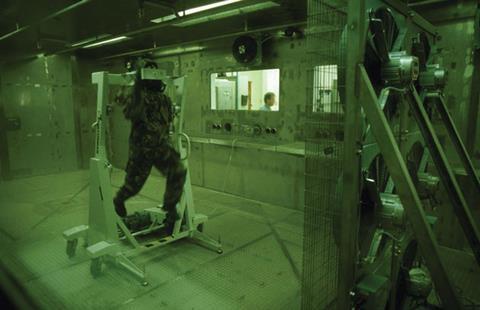
Assessing robustness falls to DSTL’s hardest-working employee: the Porton Man. This mechanical mannequin suits up to help Willis and his team see how well their materials perform on the body, and against the deadliest substances known to science. But Porton Man is soon to receive a well-earned retirement. ‘We’ve been working with i-bodi Technology who did a lot of work on [BBC TV series] Walking with dinosaurs. We’ve produced a next-generation mannequin with real-time dosimeters, based on the miniature ion mobility spectrometers, so we can measure in real time how a suit is performing. We can see where the weak spots are and that will help us develop better suits.’
You may even find yourself wearing some of Porton’s protective technology. Just as DSTL looks outward to identify research that could have defence applications, much of the technology developed at DSTL can be turned to civilian and commercial applications. In 2004, the plasma polymerisation technology developed at DSTL was spun out to form the company P2i, which now works with textile and electronics manufacturers to provide water-repellent finishes. ‘That’s one of our big success stories,’ says Willis. ‘I believe P2i have now got a mobile phone that can operate under a metre of water for six hours – if you want to do that sort of thing.’
Decontamination work
Despite all the efforts taken to protect, detect, identify and avoid, measures are inevitably required for those occasions where personnel come into contact with hazardous materials. ‘Given the wide spectrum of potential contaminants that we may need to decontaminate – radiological, chemical and biological – and the range of surface types from skin to sensitive electronic equipment, it’s a huge problem space,’ says Norman Govan, the CBR’s expert on decontamination processes.
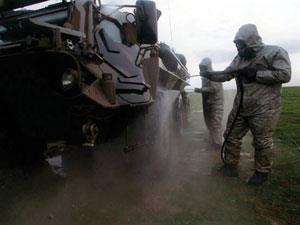
That demands a broad-spectrum approach and again, ease of use is a priority. ‘The current in-service personal decontaminant for chemicals is Fuller’s earth, which you probably are very familiar with,’ says Govan. Clay may be low-tech, but Govan also works with academic research groups using cutting-edge chemistry.
‘To reduce the burden of conducting decontamination in operational environments, our research is trying to develop technologies with the potential to remove personnel from the process altogether. Key to this is the development of materials that can trigger a favourable molecular event, such as a colour change to disclose the location of contamination, or a release of decontaminant from micro-capsules held in a self-decontaminating coating’ says Govan. Non-covalent interactions, which occur in protein binding, are an area of particular interest – for example, the enzyme acetyl-cholinesterase, which breaks down the neurotransmitter acetylcholine. Nerve agents such as the organophosphonate sarin inhibit the enzyme’s activity, leading to a constant nerve impulse, causing unceasing muscle contraction. ‘We’re still just starting to peel away the fundamental mechanisms involved in non-covalent binding of neutral molecules like organophosphonates and sulfur mustard,’ says Govan.
Another aspect of Govan’s work is developing formulations to deliver a decontaminant to a surface more effectively. ‘There’s a number of colloidal-type chemistry issues that we grapple with. We have recently developed microemulsion-based decontaminants that can be tuned, at point of use, to achieve optimal decontamination of military equipment,’ he says. ‘We envisage that molecular recognition materials of this type will be used in next generation decontaminants to target contamination hot spots and reduce the concentration of active materials that need to go into formulations.’
Reducing the use of materials also applies to Govan’s work on more effective means to tackle contamination by Bacillus anthracis (the cause of anthrax). He recalls the decontamination of the Scottish island of Gruinard in 1986, which had been left uninhabitable by B. anthracis tests performed there in the 1940s. ‘At that time, we used 200?tonnes of formaldehyde mixed in 20,000?tonnes of seawater. That wouldn’t be viable today, for a host of reasons.’ Govan is now embarking on a new research project designed around a ‘germinate and terminate’ approach. ‘The incorporation of simple amino acids into the formulation cause the spores to shed their protective coat and become more susceptible to biocides or natural decay.’
A positive legacy?
The story of Gruinard represents the unfortunate contradiction of DSTL’s CBR work: it is often necessary only because of the legacy of chemical warfare. But thanks to their efforts, and the work of the Organisation for the Prohibition of Chemical Weapons (OPCW), the world now approaches a time when stockpiles of chemical weapons may well be completely destroyed (see Destroying war’s chemical legacy).
There are so many good applications in chemistry, but there’s also a negative side
Chris Timperley
In 2013, the OPCW received the Nobel peace prize for its efforts toward eliminating chemical weapons, and as vice-chair of the OPCW scientific advisory board, Timperley was among the team that received the award, along with another DSTL employee, Robin Black. But they insist that the recognition belongs to a much larger group. ‘The prize recognised an enormous effort by diplomats over years, the scientists that have given advice and it also pays tribute to those that lost their lives, because without them, there would be no need for the convention. It’s a tremendous honour and privilege to be part of that,’ says Timperley.
DSTL also works to ensure that chemical weapons remain a thing of the past, through its non-proliferation activities. The UK is one of 42 member states of the Australia Group, set up to monitor exports of chemicals against schedules of controlled substances that could be used to produce chemical weapons. ‘They are very similar to the schedules of the Chemical Weapons Convention, but they go a little bit further than that,’ says Matt Brooks, who works in DSTL’s non-proliferation team. The Australia Group controls not only chemical agent precursors and the means to make them, but any technology that might be used in chemical weapons production. ‘Even intangible technology – the knowledge of how to do something – can be controlled,’ says Brooks. ‘An email or telephone call can count as an export.’
As chemical weapons are steadily destroyed, vigilance, awareness and education are needed to safeguard the future, says Timperley. ‘[The OPCW] are trying to come up with a code of conduct so that people are better educated on chemicals that could be misused. There are so many good applications in chemistry, but there’s also a negative side and one of them is chemical weapons. The message now is to reach out and educate people because the next generation are the ones that will inherit all the work we’ve done.’





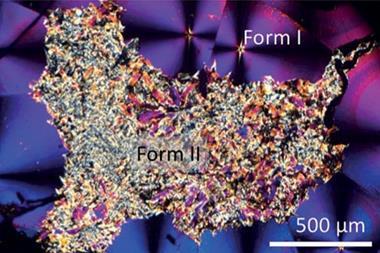













No comments yet